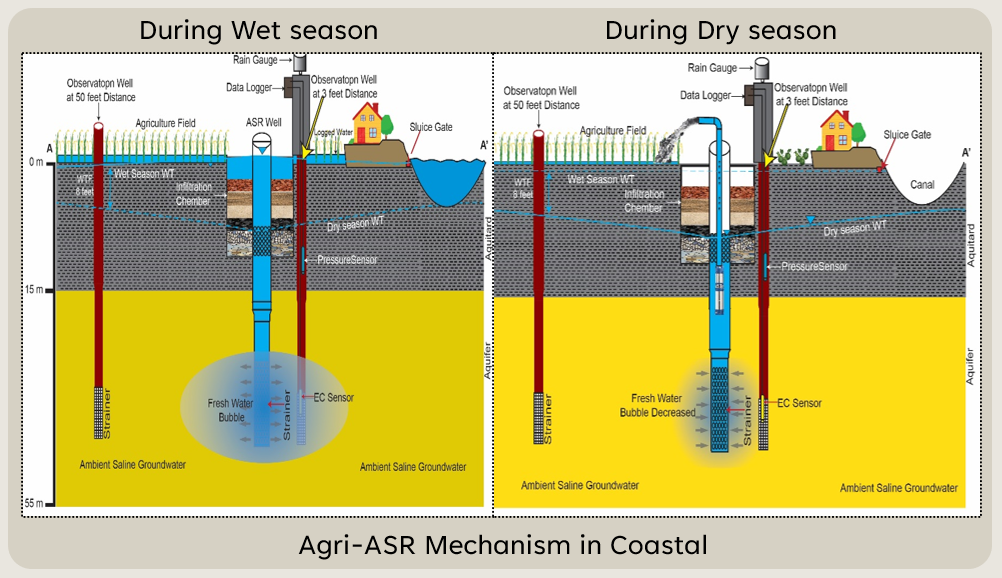ONGOING RESEARCH
Field Based Applied Research on “Aquifer Storage and Recovery (ASR)” technology for increasing cropping intensity of Bangladesh
Researche Funding: Krishi Gobeshona Foundation (KGF)
Faculty Researcher: Dr Sara Nowreen, Prof Dr Mashfiqus Salehin
Collaboration: Lead: Institute of Water and Flood Management (IWFM), BUET; Affiliate: Bangladesh Agricultural Development Corporation (BADC)
Duration: December, 2020 - December, 2023

Aquifer Storage and Recovery (ASR) is a concept of artificial recharge and has recently been promoted by Bangladesh Delta Plan 2100 under Managed Aquifer Recharge (MAR). India has many success stories of implementing ASR for increasing cropping intensity by (a) removal of waterlogging, and (b) supplying irrigation cum domestic water (Nareeta Service 2021; Shewale and Thorbole 2019). However, no field-based application has yet been attempted in Bangladesh for agricultural purposes. With this aim to increase the cropping intensity of Bangladesh, bore well aquifer type ASR is expected to be a useful, innovative water management solution for farmers facing drought, water-logged and salinity situations. ASR gets their land free from water logging in peak monsoon and during post-monsoon periods allowing farmers to access the best quality irrigation water at their farming land. ASR is an added benefit along with a salinity solution for the coastal region. Therefore, firstly, the study has been analyzing an ASR set-up in the saline prone coastal area, namely, Dacope, Khulna. Secondly, it has been assessing the possibility of using existing shallow tubewell (STW) structures in both recharging and pumping irrigation for the North region (i.e., Natore, Rajshahi, and Tangail) to the current experimental set-up of ASR. A total of fifty-six field visits to the four sites were made during the study period for (i) the removal of well clogging problem by back wash of ASR well and repairing of filter materials of the recharge pit; (ii) the estimation of infiltration rate; (iii) monitoring groundwater level of surrounding wells; and (iv) water quality tests. Automated rain gauges and dataloggers have been set for continuously measuring high-resolution (30-min) rainfall amount and groundwater level position at ASR sites of Naldanga and Dacope. Apart from these, manual groundwater levels were monitored at 15-day intervals. Dry and Pre-monsoon groundwater quality tests were completed at four sites. Water samples were collected maintaining standard protocols for quality tests within 24 hours of water sample collection. Pre- and post-project land use coverages of the whole four Upazilas under study are estimated. Topography maps were prepared and groundwater flow directions were mapped. Salinity or Electric Conductivity for monitoring wells were recorded at 15-day intervals. All these primary and secondary data were processed to contribute to the calculation of recharge amount and water quality assessment of these ASR setups. Evidence suggests that the ASR system has a number of advantages over other competing recharge systems, including the capacity to raise groundwater levels through early rainfall and monsoon floods, a reduced likelihood of contamination, and a cheaper construction cost. Recharge performances using ASR in the non-saline zone are encouraging. However, there are drawbacks, such as the fact that the system can’t deliver irrigation water all year round and that clogs always have to be removed because of the high levels of surface water turbidity and groundwater iron. In particular, its ability to reduce salinity and the abrupt rise in electrical conductivity (EC) following successive irrigation pumping raises sustainability problems. In a coastal region, the capacity of a single 12m3 filtration chamber is limited to a maximum dilution of 33,48,000 litres of saltwater before it reaches the same level of salinity as the surrounding groundwater. Therefore, our study suggests that in coastal regions, it would be more efficient to use water-efficient crops like watermelon and tomatoes instead of irrigating rice, using an ASR system. Nevertheless, the potential benefits of deploying multiple ASRs in coastal areas to enhance irrigation sustainability were not investigated throughout the study period. In summary, ASR has the capacity to recover the decline in groundwater levels and offer supplementary irrigation. Nevertheless, in order for it to be successfully implemented and effective in the long run, it will be necessary to address issues like clogging, maintaining water quality, and sustainability. This is particularly true if pollutants like organic and inorganic fertilizers, pesticides, and heavy metals are present, as they will lower the current value of the net benefits from ASR by lowering the quality of the water supply.
This Krishi Gobeshona Foundation (KGF)-funded (Tk. 87.58k) project was a collaborative effort with the Bangladesh Agricultural Development Corporation (BADC) and spanned three years and three months, from December 13, 2020, to April 12, 2024.
